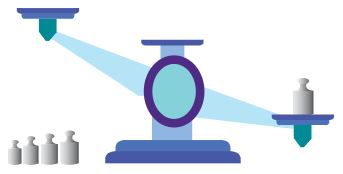Your children will likely have already been introduced to weight when comparing objects and when determining which object is “heavier” or “lighter.” In 3rd grade they will progress to take measurements using grams and kilograms as standard units of measurement. Doing this they will learn about the additive nature of such measurement where units of measurement are repeated when measuring weight in the same way as when repeating a unit to measure length.Note: There is information here that is common to your children’s understanding of weight and volume.
Balance Scales

Weighing objects using Balance Scales is an excellent introduction to measuring the weight of various objects. If you have set of these scales at home then encourage your children to use them to measure and compare weight.
Weigh household objects. Start with lighter objects that are best measured in grams. Check out this site to get ideas and guidance on the weight of different objects . With lots practice your children should be able to make reasonable estimates about the weights of objects. Have your children try the worksheet below to show their understanding of “heaviest” and “lightest.”
Grams and Kilograms
Children usually start their measurement of weights using grams before progressing to also use kilograms. In later grades they will convert weights to different units and they will at that time require a solid understanding of the relationship between grams and kilograms – with a kilogram equaling 1,000 grams. At this stage however it is more important that they can identify the types of objects that would be more suitably measured using each of these units.
Have your children try the worksheet below:
Compare Weights

Show your children how to compare weights by having them various objects in each hand. Encourage them to let the heavier object push one hand downwards and use language such as “this one is heavier”, “this one is much lighter”, “these two are about the same.”
Your children will best develop their ability to reason with weights and their measurement through hands-on activities using balance and other types of scales to measure and compare weights. The following worksheets provide exercise questions to follow on from such activities.
Being More Efficient


Check if your children have had hands-on practice measuring weights using balance scales with measuring weights other that just 1g e.g. using 2g, 5g, 10g pieces.
Taking measurement very often requires the values on a scale to be derived as graduation marks are not always annotated with their corresponding value. Have your children try the two worksheets below to practice measurement of weight.
Things to watch out for

- Some children might mistakenly generalize that larger objects are always heavier than smaller objects. Hands-on experience and practice with comparing weights is, as always, a good remedy for such misconceptions.
- Children whose number sense is still developing may struggle with estimating weights.










